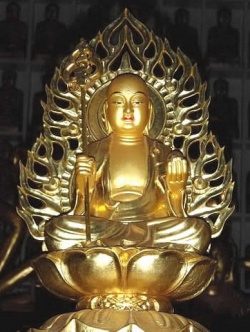Difference between revisions of "Buddha Treasury Sutra"
m (1 revision) |
|||
| Line 1: | Line 1: | ||
[[File:Es28.jpg|thumb|250px|]] | [[File:Es28.jpg|thumb|250px|]] | ||
<poem> | <poem> | ||
| − | Buddha Treasury Sutra | + | [[Buddha]] Treasury [[Sutra]] |
[仏蔵経] (Chin Fo-tsang-ching; Jpn Butsuzo ᆳkyo ) | [仏蔵経] (Chin Fo-tsang-ching; Jpn Butsuzo ᆳkyo ) | ||
| − | A sutra translated into Chinese in 405 by Kumarajiva. A Tibetan translation also exists. The [[sutra]] takes the form of a discourse between Shakyamuni and [[Shariputra]] held on Eagle Peak near Rajagriha, the capital of Magadha. It maintains that all phenomena are without birth or extinction, and that to perceive this truth of phenomena means to behold the Buddha. It also says that [[monk]]s who preach from an impure motive, i.e., to gain profit and support, suffer the retribution of falling into hell. The sutra goes on to refer to the time following the passing of the Buddha Great Adornment in the far remote past.One hundred years after Great Adornment's death, his followers split into five schools, led by the monks Universal Practice, Shore of Suffering, Sawata, Shoko, and Batsunanda, respectively. Among these five leaders, only Universal Practice correctly upheld the Buddha's teaching. The four other leaders held erroneous views and, along with their followers, cursed Universal Practice. For this reason, these four monks and their followers fell into hell. In the following section, Shakyamuni Buddha speaks of his past existences, saying that, although he practiced under various Buddhas in order to gain enlightenment, he was not given a prophecy of enlightenment by these Buddhas because of his attachment to making distinctions among phenomena and his ignorance about the truth of nonsubstantiality. | + | A [[sutra]] translated into {{Wiki|Chinese}} in 405 by [[Kumarajiva]]. A [[Tibetan]] translation also [[exists]]. The [[sutra]] takes the [[form]] of a {{Wiki|discourse}} between [[Shakyamuni]] and [[Shariputra]] held on Eagle Peak near [[Rajagriha]], the capital of [[Magadha]]. It maintains that all [[phenomena]] are without [[birth]] or [[extinction]], and that to perceive this [[truth]] of [[phenomena]] means to behold the [[Buddha]]. It also says that [[monk]]s who preach from an [[impure]] motive, i.e., to gain profit and support, [[suffer]] the retribution of falling into [[hell]]. The [[sutra]] goes on to refer to the [[time]] following the passing of the [[Buddha]] Great Adornment in the far remote past.One hundred years after Great Adornment's [[death]], his followers split into five schools, led by the [[monks]] [[Universal]] Practice, Shore of [[Suffering]], Sawata, Shoko, and Batsunanda, respectively. Among these five leaders, only [[Universal]] Practice correctly upheld the [[Buddha's teaching]]. The four other leaders held erroneous [[views]] and, along with their followers, cursed [[Universal]] Practice. For this [[reason]], these four [[monks]] and their followers fell into [[hell]]. In the following section, [[Shakyamuni Buddha]] speaks of his past [[existences]], saying that, although he practiced under various [[Buddhas]] in [[order]] to gain [[enlightenment]], he was not given a [[prophecy]] of [[enlightenment]] by these [[Buddhas]] because of his [[attachment]] to making distinctions among [[phenomena]] and his [[ignorance]] about the [[truth]] of [[nonsubstantiality]]. |
</poem> | </poem> | ||
{{R}} | {{R}} | ||
Revision as of 17:32, 3 September 2013
Buddha Treasury Sutra
[仏蔵経] (Chin Fo-tsang-ching; Jpn Butsuzo ᆳkyo )
A sutra translated into Chinese in 405 by Kumarajiva. A Tibetan translation also exists. The sutra takes the form of a discourse between Shakyamuni and Shariputra held on Eagle Peak near Rajagriha, the capital of Magadha. It maintains that all phenomena are without birth or extinction, and that to perceive this truth of phenomena means to behold the Buddha. It also says that monks who preach from an impure motive, i.e., to gain profit and support, suffer the retribution of falling into hell. The sutra goes on to refer to the time following the passing of the Buddha Great Adornment in the far remote past.One hundred years after Great Adornment's death, his followers split into five schools, led by the monks Universal Practice, Shore of Suffering, Sawata, Shoko, and Batsunanda, respectively. Among these five leaders, only Universal Practice correctly upheld the Buddha's teaching. The four other leaders held erroneous views and, along with their followers, cursed Universal Practice. For this reason, these four monks and their followers fell into hell. In the following section, Shakyamuni Buddha speaks of his past existences, saying that, although he practiced under various Buddhas in order to gain enlightenment, he was not given a prophecy of enlightenment by these Buddhas because of his attachment to making distinctions among phenomena and his ignorance about the truth of nonsubstantiality.
